Abstract
Herein, we report on the bulk synthesis of (Cr 1−xMn x)2AlC and (Cr1−yMny)2GaC MAX phases. Scanning electron and transmission electron microscopy, in combination with energy-dispersive X-ray spectroscopy performed locally on MAX phase grains, revealed x and y to be 0.06 (3 at%) and 0.3 (15 at%), respectively. The introduction of Mn into the structure did not result in appreciable changes in the c-lattice constants. Vibrating sample magnetometry measurements suggest that bulk (Cr0.7Mn0.3)2GaC may be magnetic.
1. Introduction
The MAX phases constitute a family of inherently nanolaminated ternary compounds with a general composition of (M—early transition metal, A—A-group element, X—C or N, n = 1–3).[Citation1,Citation2] Different stoichiometries are often referred to as 211, 312, and 413. Following their discovery in the 1960s,[Citation1] the MAX phases have attracted increased attention more recently due to a unique combination of metallic and ceramic properties, originating from the presence of both metallic and covalent bonds between different atomic layers.[Citation2] Some of them are not only oxidation and thermal shock resistant, but are also good electric and thermal conductors. In addition, the MAX phases are readily machinable and extremely damage tolerant. More than 60 pure MAX phases and a large number of their solid solutions have been synthesized and characterized to date.[Citation2]
Partial substitution of the M, A, or X elements is a process by which the MAX phase properties can be tailored. For example, the elastic modulus of Ti(Si,Al)C
, [Citation3] hardness of (Ti,V)2AlC,[Citation4] and conductivity of (Ti,Nb)2AlC [Citation5] can be tuned in between the values of the end members. To date, most of the substitutions have been with elements chosen from those used in previously synthesized MAX phases. It is reasonable to assume, however, that substitutions from outside the constellation of elements known to form MAX phases are likely to provide more pronounced property changes or even new characteristics. For example, replacing the C by O in Ti2AlC is predicted to tune the conductivity along the c-axis.[Citation6]
More germane to this work is the theoretical predictions that Mn can form solid solutions on the M sites, and that the resulting compounds would be magnetic.[Citation7] Both predictions were subsequently experimentally realized in (Cr,Mn)2AlC [Citation8,Citation9] and (Cr,Mn)2GeC [Citation10] thin films. Very recently, the existence of the first Mn-based MAX phase, Mn2GaC, has been reported.[Citation11] Most importantly (Cr,Mn)2GeC [Citation10] and Mn2GaC [Citation11] thin films have been shown to exhibit a magnetic response, including a ferromagnetic (FM) contribution up to transition temperatures of 200 and 230 K, respectively. Furthermore, tuning of the magnetic state (FM vs. antiferromagnetic (AFM)) depending on the Cr–Mn atomic configurations on the M-sublattice was suggested for both (Cr,Mn)2AlC [Citation7] and (Cr,Mn)2GeC.[Citation10]
To date, most of the work on Mn incorporation into MAX phases has been carried out on thin films. Reports on the synthesis and characterization of bulk samples have focused on (Cr,Mn)2GaC [Citation12] and (Cr,Mn)2GeC.[Citation13,Citation14] Up to 12.5 at% Mn content has been achieved in (Cr,Mn)2GeC, in agreement with corresponding thin films,[Citation10] and an increase in Curie temperature as well as magnetic moment per M-atom has been demonstrated with increased Mn concentration. For (Cr,Mn)2GaC, however, no attempts were made to measure changes in magnetic properties upon Mn incorporation. It is important to note that in Ref.,[Citation12] the claimed Mn content of 7.5 and 25 at% was based on the composition of the initial powder mixtures only. As shown herein, this does not necessarily correspond to the composition obtained in the MAX phase after synthesis.
The discovery of these Mn-containing MAX phases reveals a new group of solids of inherent atomic laminates with potentially tunable magnetic properties. This motivates further experimental and theoretical investigations on Mn incorporation into the MAX phase under conditions closer to thermodynamic equilibrium, as compared to thin film synthesis. The purpose of this work is to report on the synthesis of bulk (Cr1−xMnx)2AlC and (Cr1−yMny)2GaC phases. The difference in Mn incorporation was investigated through careful local, as well as average composition analysis. In addition, preliminary magnetic characterization was performed.
2. Experimental Details
A series of (Cr,Mn)2AlC samples with Cr:Mn:Al:C molar ratios of 2:0:1.3:1, 1.8:0.2:1.3:1, 1.6:0.4:1.3:1, 1.2:0.8:1.3:1, 0.8:1.2:1.3:1, and 0.4:1.6:1.3:1 were synthesized. The powders used (all from Alfa Aesar, Ward Hill, MA) were Cr (99%, −325 mesh), Mn (99.3%, −325 mesh), Al (99.5%, −325 mesh), and graphite (99%, −300 mesh). The powders were mixed, cold pressed (at 400 MPa) and heated to 1, 400°C for 1 h under Ar flow. In order to get a fully dense (Cr,Mn)2AlC sample, a powder mixture with Cr:Mn 1.8:0.2 was hot-pressed, HPed, in a graphite heated, vacuum-atmosphere HP (Series 3600, Centorr Vacuum Industries, Somerville, MA) at 1, 400°C and 39 MPa for 3 h.
Due to its low melting point (29°C), Ga could not be effectively mixed with powders of the remaining three elements, therefore a different synthesis set-up was used. Initial powder mixtures of Cr, Mn and graphite were contained in cylindrical alumina crucibles and Ga (99%, Alfa Aesar, Ward Hill, MA) pellets were placed on top. Upon melting, the Ga wet the other powders and reacted with them. The crucibles with powder were degassed at 140°C for 10 h in a mechanical vacuum and then inserted into a glass tube which was evacuated, heated to 975°C at a rate of 15°C/min, and held at that temperature for 24 h. Five (Cr,Mn)2GaC samples with Cr:Mn:Ga:C molar ratios of 2:0:1:1, 1.5:0.5:1:1, 1:1:1:1, 0.5:1.5:1:1, and 0:1:1:1 were synthesized.
Phase identification was performed using a X-ray diffraction (XRD) diffractometer (Panalytical Empyrian MRD) equipped with a line focus CuKα source. A scanning electron microscope, SEM (LEO 1550), equipped with energy-dispersive X-ray (EDX) detector (Oxford Instruments X-Max) was used for compositional analysis.
A transmission electron microscope, TEM (Tecnai G2 TF20 UT FEG), equipped with an EDX detector (EDAX) was also used for sample characterization. The TEM samples were prepared from powder suspensions in ethanol evaporated on a carbon-coated grid. TEM imaging and selected area electron diffraction (SAED) were performed at 200 kV. Vibrating sample magnetometry (VSM) was used for dc magnetization measurements. The VSM characterization was carried out in a Physical Properties Measurement System (Quantum Design). Since sample purity is crucial for magnetic measurements, the (Cr,Mn)2GaC samples were treated with concentrated HCl (37%) to dissolve any impurity phases prior to the VSM measurements.
3. Results and Discussion
3.1. (Cr,Mn)2 AlC
X-ray θ–2θ analysis revealed the formation of the 211 phase in samples with initial Cr:Mn ratios of 2:0, 1.8:0.2, and 1.6:0.4. Gradually increasing the Mn content in the initial powder mixture led to the formation of competing phases, primarily Mn3AlC. Concomitantly, a substantial decrease in 211 phase peak intensities was observed. presents a θ–2θ scan of a HPed sample with Cr:Mn ratio of 1.8:0.2. The Cr7C3 peaks most likely formed due to excess C provided by the graphite sheets used to separate the initial powder from the punch surfaces.
Powders of the sample with a Cr:Mn ratio of 1.8:0.2 were mixed with 10 wt% Si powder as an internal reference for XRD. After scan adjustment, a c-lattice parameter of 12.85 Å and a-lattice parameter of 2.85 Å were calculated from Bragg's law.
(a) shows a typical fractured surface of the HPed (Cr,Mn)2AlC sample with the initial Cr:Mn ratio of 1.8:0.2, revealing large (20–40 μm in diameter) layered grains typical of the MAX phases. This can be better seen from (b), where the nanolaminated structure, combined with the high c/a ratio and relatively weak metallic bonds between M- and A-layers, results in the formation of typical kink bands and delaminations.[Citation15]
Figure 2. Typical SEM image of a fracture surface of a HPed (Cr,Mn)2AlC sample with an initial Cr:Mn ratio of 1.8:0.2 at (a) low magnification and (b) higher magnification. Kinking and delamination of MAX phase grains are obvious in (b).
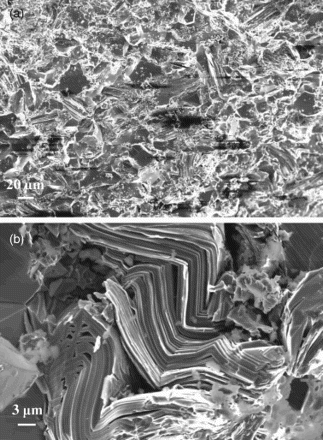
SEM-EDX point analysis on 10 different MAX phase grains in in different areas was performed. Homogeneous Mn incorporation with a Cr:Mn ratio of 15.3:1 was measured. In other words, assuming that the Mn replaces the Cr atoms, the Mn concentration was 3±1 at% and the resultant MAX phase composition is thus (Cr0.94Mn0.06)2AlC.
A high-resolution TEM image of a (Cr,Mn)2AlC region is shown in (a), again revealing the characteristic nanolaminated nature of the material. Local EDX analysis performed on selected MAX phase grains yielded Mn concentration values of 3±1 at%, in good agreement with SEM-EDX quantification.
3.2. (Cr,Mn)2 GaC
XRD diffraction patterns of the Cr2GaC samples showed that in addition to the 211 phase, peaks belonging to the inverse perovskite, Mn3GaC, and graphite were observed. A typical example is shown in for a (Cr,Mn)2GaC sample with a Cr:Mn ratio of 1:1 in the initial powder. The c- and a-lattice parameters were calculated from the XRD patterns – using Si as an internal standard—to be 12.62 and 2.89 Å, respectively.
Figure 4. XRD θ–2θ scans of (a) (Cr,Mn)2GaC sample with a Cr:Mn ratio of 1:1 in the initial powder and, (b) HCl treated (Cr,Mn)2GaC sample.
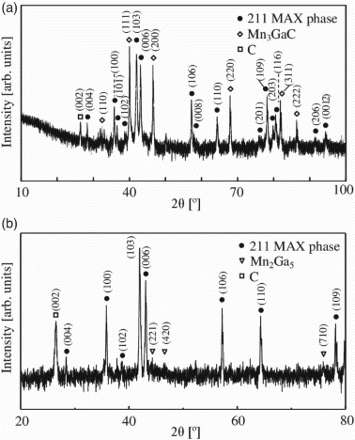
(a) and 5(b) shows typical fractured surfaces of the (Cr,Mn)2GaC sample with a Cr:Mn ratio of 1:1. Here again, kink bands typical of the MAX phases are obvious ((b)).
Figure 5. (a) SEM overview image of fracture surface of (Cr,Mn)2GaC. MAX phase appears as layered grains with typical diameters of 20–40 μm and, (b) kink band in individual grain.
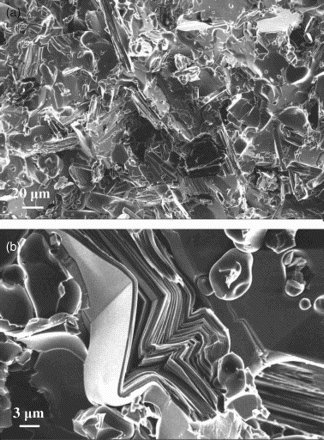
EDX point analysis has been performed on 10 MAX phase grains in the Cr:Mn 1:1 sample in different areas, for all grains giving a :Ga ratio of 2:1, which corresponds to the M:A element ratio in a stoichiometric n=1 MAX phase. As EDX does not provide accurate values for light elements, especially C, its content was not quantified. From the measured Cr:Mn ratio of 2.4:1 and assuming that
at%, the Mn concentration can be determined to be 15 at%, corresponding to the substitution of almost one-third of the Cr atoms and a resulting MAX phase composition of (Cr0.7Mn0.3)2GaC. Furthermore, the small standard deviation (±1 at%) from the average value indicates a homogeneous Mn incorporation in the MAX phase across the sample. Samples with an initial powder composition with a Cr:Mn ratio of 1.5:0.5 resulted in 8±1 at% Mn being incorporated into the MAX phase, i.e. (Cr0.84Mn0.16)2GaC.
TEM analysis, including SAED of the sample with 15 at% Mn content, is presented in (b)–(d), showing a MAX phase grain oriented along the [100] zone axis. SAED patterns along the [1
00] and [11
0] zone axes were recorded from a single MAX phase grain, as presented in (c) and 3(d), respectively. SAED in combination with accordingly determined lattice constants of a=2.94 Å and c=12.59 Å, in turn consistent with the XRD analysis, allows unambiguous identification of the MAX phase structure.
Composition analysis of well-separated MAX phase grains has also been performed in TEM-EDX, where the Cr, Mn, and Ga elemental ratio was found to be 46.7:20.0:33.3, respectively. The combined ratio is thus 2:1 and the resultant Mn concentration, assuming
at%, is 15±1 at%. In other words, these results are in excellent agreement with those determined from SEM-EDX and confirm that the Mn is uniformly incorporated across the sample.
3.3. Solubility Differences
Interestingly, the latt- ice parameters of the (Cr0.94Mn0.06)2AlC, (Cr0.84Mn0.16)2GaC, and (Cr0.7Mn0.3)2GaC samples determined from Bragg's law and the XRD patterns obtained herein are in good agreement with the values of c=12.82 Å and a=2.86 Å [Citation16] as well as c=12.63 Å and a=2.90 Å [Citation17] experimentally obtained for the end members Cr2AlC and Cr2GaC, respectively. They are also in good agreement with their respective theoretically calculated values of 12.73 Å [Citation18] and 12.54 Å.[Citation19] It follows that the incorporation of Mn in these compounds does not affect the c-lattice parameters. This is also in agreement with recently synthesized (Cr0.84Mn0.16)2AlC thin films which show that the c-lattice parameter remains unchanged when Mn substitutes for Cr.[Citation8]
Our observations are at odds with the claims that the (103) peaks shift towards higher angles in a previous report on the bulk synthesis of (Cr,Mn)2GaC.[Citation12] This shift was used as evidence for Mn incorporation into the MAX phase. However, without fixed reference peaks, the reported shifts in between the samples with different initial powder ratios cannot be unambiguously ascribed as originating from different MAX phase compositions, e.g. minor height misalignment may also result in shifts in the XRD scan. In addition, although shifted with respect to pure Cr2GaC, the (103) peak position for the two different Cr:Mn ratios (in the initial powders) in Ref. [Citation12] is the same, in turn indicating the same level of Mn incorporation; an observation that is not discussed by the authors. For the closely related (Cr,Mn)2GeC system, a small non-linear dependence of the lattice parameters has been measured by Liu et al.,[Citation14] however, not detected in the study by Tao et al. [Citation13] which resulted in values identical to pure Cr2GeC.
Furthermore, theoretical calculations predict the incorporation of at least 30 at% Mn into (Cr,Mn)2AlC [Citation7] and 10 at% Mn was reported in thin film form.[Citation9] As noted above, the stability of Mn2GaC was theoretically predicted and very recently experimentally confirmed.[Citation11] Herein, the Mn solubility limits were 3 and 15 at%, in the Al- and Ga-containing systems, respectively. The differences between levels of Mn incorporation in the thin films vs. the bulk samples can be explained by the synthesis conditions. In contrast to bulk synthesis, thin film growth is performed far from thermodynamic equilibrium, which can result in enhanced solubility limits. Moreover, epitaxial stabilization may allow realization of materials and compositions not achieved by bulk synthesis methods.[Citation20,Citation21] The formation of MAX phases in thin film deposition can also be promoted, over competing phases, by the choice of substrate—most often Al2O3(0001) or MgO(111)—providing a template corresponding to the MAX phase a-lattice spacing.
It is important to point out that the measured Cr:Mn ratios in the quaternary compounds deviate from their ratios in the initial powder mixtures. For example, if all the initial Mn were incorporated into the (Cr,Mn)2AlC compound, its concentration would have been 5 at% compared with the 3 at% observed. Similarly, if all the initial Mn were incorporated into the (Cr,Mn)2GaC compound, its concentration would have been 25 at%, instead of the 15 at% measured. Furthermore, no MAX phase was formed when the Mn content in the initial powder exceeded 25 at%, although the elemental powders were mixed in ratios corresponding to the stoichiometric 211 phase. The deviation from the initial powder composition may be explained by the thermodynamically governed solubility limit, as well as the formation of competing phases, primarily the inverse perovskites Mn3AC (A=Al, Ga) at higher Mn contents.[Citation7,Citation8,Citation11,Citation19] Obviously, the sample composition after synthesis cannot be deduced from the initial power mixture; local elemental analysis must be performed after synthesis to determine the solubility limits.
In both the Cr–Mn–Al–C and Cr–Mn–Ga–C systems, the inverse perovskites, Mn3AlC and Mn3GaC, respectively, were experimentally observed, in agreement with theoretical calculations.[Citation7] In bulk synthesis, elements can be mixed in exact stoichiometric ratios, which for thin films often require optimization of the growth conditions due to different atom sticking coefficients that, in turn, depend on other factors such as, e.g. substrate temperature. Therefore, the predicted and actually observed competing phases in bulk and thin film samples may differ due to possible deviations in stoichiometry.
3.4. Magnetism
Temperature-dependent suscepti- bility measurements of bulk Cr2AlC and Cr2GaC have concluded that they were Pauli paramagnets.[Citation22] According to theoretical calculations, the magnetic ground states of Cr2AlC [Citation18] and Cr2GaC [Citation19,Citation23] are AFM. As noted above, changes in the magnetic states upon incorporation of Mn were theoretically predicted and experimentally confirmed in Mn2GaC,[Citation11] (Cr,Mn)2AlC,[Citation8,Citation9] and (Cr,Mn)2GeC thin films [Citation10] and more recently in bulk samples.[Citation13,Citation14] Various hypothetical configurations of Cr–Mn ordering on the M-sublattice were also theoretically investigated for (Cr,Mn)2AlC [Citation7] and (Cr,Mn)2GeC [Citation10] resulting in FM states being predicted to be either more stable or degenerate with the AFM states.
Prior to the magnetic measurements, the (Cr,Mn)2GaC sample with Cr:Mn 1:1 in the initial powder was treated with concentrated HCl in order to dissolve the majority of impurity phases. Subsequent XRD analysis, presented in (b), combined with SEM-EDX revealed the presence of C and a minor amount of the Mn2Ga5 phase. No other impurity phases, such as Mn3GaC, were detected.
presents the temperature dependence of the specific magnetic moment determined by VSM of the HCl treated (Cr,Mn)2GaC sample in the 10–370 K range at a magnetic field of 0.05 T. A relatively large and abrupt change in magnetization is observed at 153 K; a smaller change is observed at 38 K. Since neither of these temperatures correspond to a magnetic transition temperature of any of known magnetic phases in the Cr–Mn–Ga–C system, such as Mn2Ga (690 K),[Citation24] Mn3Ga (743 K),[Citation24] Mn8Ga5 (210 K),[Citation24] MnGa6 (420 K),[Citation25] MnGa4 (453 K),[Citation25] Mn2Ga5 (451 K),[Citation25] Mn3Ga5 (63 K),[Citation25] or Mn7Ga6 (480 K),[Citation25] it is reasonable to assume that (Cr,Mn)2GaC is a magnetic phase. This conclusion is further supported by similar observations in the (Cr,Mn)2GeC system very recently reported by Tao et al.,[Citation13] where transitions in magnetization as a function of temperature were observed at ∼ 30 and 120–320 K, the latter as a function of Mn concentration. The behavior has been suggested to originate from phase separation into Mn-rich and Mn-poor regions on the nanoscale, Mn-rich regions having an FM component with a Curie temperature that depends on the Mn content, and Mn-poor regions exhibiting a re-entrant cluster glass transition at low temperature. As the investigated sample contains a small fraction of Mn2Ga5 (Curie temperature of 451 K),[Citation25] the magnetic response may be affected through an increased background signal, visible in the 153–370 K range. At this time it is not clear why Lin et al. [Citation12] did not observe a comparable signal.
Figure 6. Specific magnetic moment as a function of temperature for the (Cr0.7Mn0.3)2GaC sample, showing evidence for magnetic transitions at 38 and 153 K.
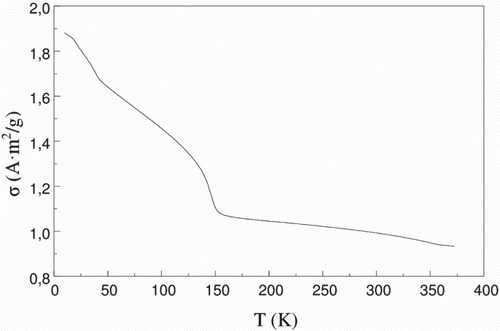
VSM measurements of magnetization as a function of applied magnetic field as well as temperature were also performed on the synthesized HPed (Cr0.94Mn0.06)2AlC sample. However, no magnetic transitions in the temperature range of 2–300 K or any FM response was detected, which is consistent with the AFM state predicted for the closely related Cr2AlC phase.
4. Conclusions
In conclusion, we synthesized bulk (Cr,Mn)2AlC and (Cr,Mn)2GaC MAX phases. Using EDX analysis we show that the maximum solubilities of Mn in Cr2AlC and Cr2GaC are 3 and 15 at%, respectively. The corresponding compositions are therefore (CrMn
AlC and (Cr0.7Mn0.3)2GaC. This implies that in the latter composition, roughly one-third of the M-lattice sites are occupied by Mn atoms. XRD θ-2θ analysis revealed no shift of the MAX phase peaks upon Mn incorporation. VSM analysis of (Cr,Mn)2GaC indicates that the material may be magnetic.
Acknowledgements
The research leading to these results has received funding from the European Research Council under the European Community's Seventh Framework Programme (FP7/2007-2013)/ERC Grant agreement no. [258509]. J. R. also acknowledges funding from the Swedish Research Council (VR), grant no. [621-2012-4425] and [642-2013-8020], and from the Knut and Alice Wallenberg (KAW) Academy Fellowship Program. M. W. B. acknowledges the support of the the SSF synergy grant FUNCASE Functional Carbides and Advanced Surface Engineering.
References
- Nowotny H. Struktuchemie einiger Verbindungen der Ubergangsmetalle mit den Elementen C, Si, Ge, Sn. Prog Solid State Chem. 1970;2:27–62. doi: 10.1016/0022-4596(70)90028-9
- Barsoum MW. MAX phases: properties of machinable ternary carbides and nitrides. Wiley-VCH; 2013.
- Radovic M, Barsoum MW, Ganguly A, Zhen T, Finkel P, Kalidindi SR, Lara-Curzio E. On the elastic properties and mechanical damping of Ti3SiC2, Ti3GeC2, Ti3Si0.5Al0.5C2 and Ti2AlC in the 300–1573 K temperature range. Acta Mater. 2006;54:2757–2767. doi: 10.1016/j.actamat.2006.02.019
- Meng FL, Zhou YC, Wang J. Strengthening of Ti2AlC by substituting Ti with V. Scr Mater. 2005;53:1369–1372. doi: 10.1016/j.scriptamat.2005.08.030
- Barsoum MW, Salama I, El-Raghy T, Golczewski J, Porter WD, Wang H, Seifert HJ, Aldinger F. Thermal and electrical properties of Nb2AlC, (Ti,Nb)2AlC and Ti2AlC. Metall Mater Trans A. 2002;33:2775–2779. doi: 10.1007/s11661-002-0262-7
- Rosen J, Dahlqvist M, Simak SI, McKenzie DR, Bilek MMM. Oxygen incorporation in Ti2AlC: tuning of anisotropic conductivity. Appl Phys Lett. 2010;97:073103. doi: 10.1063/1.3472280
- Dahlqvist M, Alling B, Abrikosov IA, Rosen J. Magnetic nanoscale laminates with tunable exchange coupling from first principles. Phys Rev B. 2011;84(22):220403. doi: 10.1103/PhysRevB.84.220403
- Mockute A, Dahlqvist M, Emmerlich J, Hultman L, Schneider JM, Persson POÅ, Rosen J. Synthesis and ab initio calculations of nanolaminated (Cr,Mn)2AlC compounds. Phys Rev B. 2013;87:094113. doi: 10.1103/PhysRevB.87.094113
- Mockute A, Persson POÅ, Magnus F, Ingason AS, Olafsson S, Hultman L, Rosen J. Synthesis and characterization of arc deposited magnetic (Cr,Mn)2AlC MAX phase films. Phys Status Solidi RRL. 2014;8(5):420–423.
- Ingason AS, Mockute A, Dahlqvist M, Magnus F, Olafsson S, Arnalds U, Alling B, Abrikosov IA, Hjorvarsson B, Persson POÅ, Rosen J. Magnetic self-organized atomic laminate from first principles and thin film synthesis. Phys Rev Lett. 2013;110:195502. doi: 10.1103/PhysRevLett.110.195502
- Ingason AS, Petruhins A, Dahlqvist M, Magnus F, Mockute A, Alling B, Hultman L, Abrikosov IA, Persson POÅ, Rosen J. A nanolaminated magnetic phase: Mn2GaC. Mater Res Lett. 2014;2:89–93.
- Lin S, Tong P, Wang BS, Huang YN, Lu WJ, Shao DF, Zhao BC, Song WH, Sun YP. Magnetic and electric/thermal transport properties of Mn-doped Mn+1AXn phase compounds Cr2−xMnxGaC (0≤x≤1). J Appl Phys. 2013;113:053502. doi: 10.1063/1.4789954
- Tao QZ, Hu CF, Lin S, Zhang HB, Li FZ, Qu D, Wu ML, Sun YP, Sakka Y, Barsoum MW. Coexistence of ferromagnetic and a re-entrant cluster glass state in the layered quaternary (Cr1−xMnxGeC). Mater Res Lett. 2014. doi:10.1080/21663831.2014.909542
- Liu Z, Waki T, Tabata Y, Nakamura H. Mn-doping-induced itinerant-electron ferromagnetism in Cr2GeC. Phys Rev B. 2014;89:054435. doi: 10.1103/PhysRevB.89.054435
- Barsoum MW, Farber L, El-Raghy T. Dislocations, kink bands and room-temperature plasticity of Ti3SiC2. Metall Mater Trans A. 1999;30:1727–1738. doi: 10.1007/s11661-999-0172-z
- Schuster JC, Nowotny VH, Vaccaro C. The ternary systems: Cr–Al–C, V–Al–C, and Ti–Al–C and the behavior of H-phases (M2AlC). J Solid State Chem. 1980;32: 213–219.
- Etzkorn J, Ade M, Kotzott D, Kleczek M, Hillebrecht H. Ti2GaC, Ti4GaC3 and Cr2GaC - Synthesis, crystal growth and structure analysis of Ga-containing MAX-phases Mn+1GaCn with , Cr and n=1, 3. J Solid State Chem. 2009;182(5):995–1002. doi: 10.1016/j.jssc.2009.01.003
- Dahlqvist M, Alling B, Rosen J. Correlation between magnetic state and bulk modulus of Cr2AlC. J Appl Phys. 2013(113):216103. doi: 10.1063/1.4808239
- Petruhins A, Ingason AS, Dahlqvist M, Mockute A, Junaid M, Birch J, Lu J, Hultman L, Persson POÅ, Rosen J. Phase stability of Crn+1GaCn MAX phases from first principles and Cr2GaC thin-film synthesis using magnetron sputtering from elemental targets. Phys Status Solidi RRL. 2013;7(11):971–974.
- MacManus-Driscoll JL, Zerrer P, Wang H, Yang H, Yoon J, Fouchet A, Yu R, Blamire MG, Jia Q. Strain control and spontaneous phase ordering in vertical nanocomposite heteroepitaxial thin films. Nat Mater. 2008;7:314–320.
- Chen A, Zhou H, Bi Z, Zhu Y, Luo Z, Bayraktaroglu A, Philips J, Choi E-M, MacManus-Driscoll JL, Pennycook SJ, Narayan J, Jia Q, Zhang X, Wang H. A new class of room-temperature multiferroic thin films with bismuth-based supercell structure. Adv Mater. 2013;25: 1028–1032. doi: 10.1002/adma.201203051
- Liu Z, Waki T, Tabata Y, Yuge K, Nakamura H, Watanabe I. Magnetic ground state of the Mn+1AXn-phase nitride Cr2GaN. Phys Rev B. 2013;88:134401. doi: 10.1103/PhysRevB.88.134401
- Dahlqvist M, Alling B, Rosen J. Magnetic ground state of Cr2AlC, Cr2GaC, and Cr2GeC from first-principles - interplay of spin configurations and strong electrons correlation. Submitted for publication.
- Overberg ME, Thaler GT, Abernathy CR, Theodoropoulou NA, McCarthy KT, Arnason SB, Lee JS, Lim JD, Shim SB, Suh KS, Khim ZG, Park YD, Pearton SJ, Hebard AF. Growth of the diluted magnetic semiconductor GaMnN by molecular-beam epitaxy. J Electron Mater. 2003;32(5):298–306. doi: 10.1007/s11664-003-0148-5
- Wijn HPJ, editor. Springer materials - the Landolt-Börnstein database. Available from: http://www.springermaterials.com. doi:10.1007/10350805_58

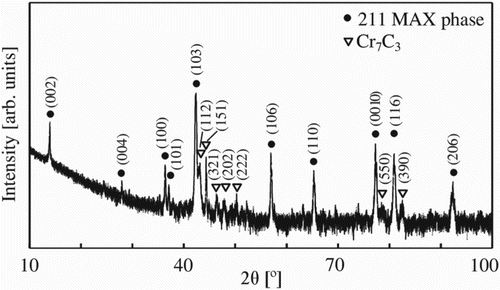
![Figure 3. Characteristic nanolaminated structure of (a) (Cr,Mn)2AlC and, (b) (Cr,Mn)2GaC; (c) and (d) SAED patterns along the [11¯00] and [112¯0] zone axis, respectively, in (Cr,Mn)2GaC.](/cms/asset/663f87bf-6477-4e56-a42d-37b9a618aed7/tmrl_a_944676_f0003_b.gif)